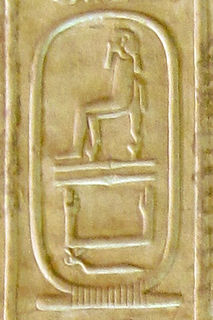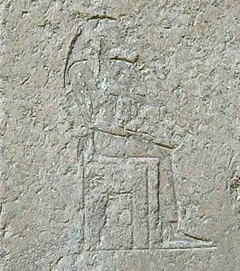Related Research Articles

Khafra was an ancient Egyptian king (pharaoh) of the 4th Dynasty during the Old Kingdom. He was the son of Khufu and the throne successor of Djedefre. According to the ancient historian Manetho, Khafra was followed by king Bikheris, but according to archaeological evidence he was instead followed by king Menkaure. Khafra was the builder of the second largest pyramid of Giza. The view held by modern Egyptology at large continues to be that the Great Sphinx was built in approximately 2500 BC for Khafra. Not much is known about Khafra, except from the historical reports of Herodotus, writing 2,000 years after his life, who describes him as a cruel and heretical ruler who kept the Egyptian temples closed after Khufu had sealed them.

Hetepheres II was a Queen of Ancient Egypt during the 4th Dynasty.

Shepseskaf was the sixth and last pharaoh of the Fourth Dynasty of Egypt during the Old Kingdom. He reigned 6 to 8 years starting circa 2510 BC. The only activities firmly datable to his reign are the completion of the temple complex of the Pyramid of Menkaure and the construction of its own mastaba tomb at South Saqqara, the Mastabat al-Fir’aun, "stone bench of the pharaoh".

Queen Meresankh III was the daughter of Hetepheres II and Prince Kawab and a granddaughter of the Egyptian pharaoh Khufu. She was the wife of King Khafre.
Meritites I was an ancient Egyptian queen of the 4th Dynasty. Her name means "Beloved of her Father". Several of her titles are known from a stela found at Giza. She was buried in the middle Queen’s Pyramid in Giza.

Kawab is the name of an ancient Egyptian prince of the 4th Dynasty. He was the eldest son of King Khufu and Queen Meritites I. Kawab served as vizier and was buried in the double mastaba G 7110 - 7120 in the east field which is part of the Giza Necropolis.

Henutsen is the name of an ancient Egyptian queen consort who lived and ruled during the 4th dynasty of the Old Kingdom Period. She was the second or third wife of pharaoh Khufu and most possibly buried at Giza.
Khufukhaf I was an ancient Egyptian prince and vizier of the 4th Dynasty.
Thamphthis is the hellenized name of an ancient Egyptian ruler (pharaoh) of the 4th dynasty in the Old Kingdom, who may have ruled around 2500 BC under the name Djedefptah for between two and nine years. His original Egyptian name is lost, but it may have been Djedefptah or Ptahdjedef according to William C. Hayes. Thamphthis is one of the shadowy rulers of the Old Kingdom, since he is completely unattested in contemporary sources. For this reason, his historical figure is discussed intensely by historians and Egyptologists.
Nefermaat II was a member of the Egyptian royal family during the 4th Dynasty and vizier of Khafra.

Meresankh II was a Queen of Egypt who lived during 4th Dynasty.

Khentkaus I, also referred to as Khentkawes, was a royal woman who lived in ancient Egypt during both the Fourth Dynasty and the Fifth Dynasty. She may have been a daughter of king Menkaure, the wife of both king Shepseskaf and king Userkaf, the mother of king Sahure. Some suggest that she was the regent for one of her sons. Perhaps, in her own right, she may have been the king of Upper and Lower Egypt, which aspects of her burial suggests. Her mastaba at Giza – tomb LG100 – is located very close to Menkaure's pyramid complex. This close connection may point to a family relationship. Although the relationship is not clear, the proximity of the pyramid complex of Khentkaus to that of king Menkaure has led to the conjecture that she may have been his daughter.

Senedjemib Mehi was a vizier from the fifth dynasty of Egypt. Senedjemib Mehi started out his career under Djedkare Isesi and eventually became vizier under Unas.

Meritites II or Meritites A was a 4th Dynasty Princess of Ancient Egypt, and probably a daughter of King Khufu. She may have been a daughter of Meritites I based on the fact that this queen is mentioned in mastaba G 7650. She married the Director of the Palace Akhethotep and she had several children with her husband. Meritites and her husband shared a mastaba G 7650 in Giza.
Nefertkau II was an Ancient Egyptian noble lady, the wife of Prince Khufukhaf I, son of pharaoh Khufu.
Khufukhaf II was an ancient Egyptian high official during the Old Kingdom period. Likely born during the 4th Dynasty, Khufukhaf died during the reign of pharaoh Nyuserre Ini of the mid 5th Dynasty. In modern Egyptology, he is also called Khufukhaf B or Khufukhaf the Younger to distinguish him from his probable father or grandfather Khufukhaf I.
Nefertkau III was an ancient Egyptian princess. She lived during the 4th Dynasty. She was possibly a daughter of Meresankh II and Horbaef. If so, she was a granddaughter of King Khufu. Baud has proposed that Nefertkau was a daughter of Khufu instead. Nefertkau has the titles King's daughter of his body and Priestess of Neith in a scene in the chapel of her tomb. She was married to an official named Iynefer. Nefertkau and Iynefer had a daughter also called Nefertkau and two or three sons. Strudwick has suggested that Iynefer may be a son of Khufu. Depending on the interpretation of the family relationships Nefertkau may have married either her uncle or her brother.

The East Field is located to the east of the Great Pyramid of Giza and contains cemetery G 7000. This cemetery was a burial place for some of the family members of Khufu. The cemetery also includes mastabas from tenants and priests of the pyramids dated to the 5th and 6th Dynasty.
Djaty I was a prince who lived in the ancient Egypt during the 4th Dynasty. He was an overseer of a royal expedition.

G1-c is one of the subsidiary pyramids of the Giza East Field of the Giza Necropolis immediately to the eastern side of the Great Pyramid of Giza, built during the Fourth dynasty of Egypt. It is the southern of the three pyramids of the queens and is the one of Queen Henutsen. It is 46.25 metres wide and had a height of 29.60 metres. A niche, four inches deep was dug in the south wall of the burial chamber. Pyramid G 1c was originally not a part of Khufu's pyramid complex, as its southern side is aligned not with the side of the Great Pyramid, but with Khufukhaf I's mastaba tomb nearby. Pyramid G 1c was at some point thought to possibly be a satellite pyramid, because it did not come with a boat pit like pyramids G 1a and G 1b. It was later determined to be an unfinished pyramid however which was constructed in a hurry. Henutsen is thought to have been buried in the tomb. Dr. Rainer Stadelmann believes Khufukhaf is the same person as Khafra and the pyramid was built by him for his mother, but this identification is doubtful.
References
- ↑ William Kelly Simpson: The Mastabas of Kawab, Khafkhufu I and II
- 1 2 Giza mastabas G7000
- ↑ William Kelly Simpson: The Mastabas of Kawab, Khafkhufu I and II